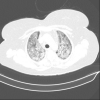Fatal disseminated infection due to Sarocladium kiliense in a diabetic patient with COVID-19
- PMID: 34631100
- PMCID: PMC8474008
- DOI: 10.1002/ccr3.4596
Fatal disseminated infection due to Sarocladium kiliense in a diabetic patient with COVID-19
Abstract
Sarocladium kiliense is a soil saprophytic mold with worldwide distribution, which can infect humans and other mammals, sporadically. The clinical manifestations include mycetoma, onychomycosis, keratomycosis, pneumonia, and arthritis. Here, we present a disseminated infection due to S. kiliense in a diabetic patient infected to coronavirus disease 2019 (COVID-19) from Isfahan, Iran.
Keywords: COVID‐19; Sarocladium kiliense; diabetic patient; disseminated infection.
© 2021 The Authors. Clinical Case Reports published by John Wiley & Sons Ltd.
Conflict of interest statement
None declared.
Figures





Similar articles
-
COVID-19-associated fungal infections in Iran: A systematic review.PLoS One. 2022 Jul 11;17(7):e0271333. doi: 10.1371/journal.pone.0271333. eCollection 2022. PLoS One. 2022. PMID: 35816494 Free PMC article.
-
Non-valvular Infective Endocarditis Caused by Sarocladium kiliense in an Immunocompromised Patient with Aplastic Anemia.Intern Med. 2022 Apr 15;61(8):1279-1283. doi: 10.2169/internalmedicine.7536-21. Epub 2021 Sep 25. Intern Med. 2022. PMID: 34565770 Free PMC article.
-
Combination therapy in the treatment of experimental invasive fungal infection by Sarocladium (Acremonium) kiliense.Int J Antimicrob Agents. 2014 Aug;44(2):136-9. doi: 10.1016/j.ijantimicag.2014.03.010. Epub 2014 Apr 30. Int J Antimicrob Agents. 2014. PMID: 24837411
-
Enhanced Specificity in Colorimetric LAMP Assay for Sarocladium kiliense Detection Using a Combination of Two Additives.J Fungi (Basel). 2024 Dec 11;10(12):857. doi: 10.3390/jof10120857. J Fungi (Basel). 2024. PMID: 39728353 Free PMC article.
-
Sarocladium and Acremonium infections: New faces of an old opportunistic fungus.Mycoses. 2020 Nov;63(11):1203-1214. doi: 10.1111/myc.13169. Epub 2020 Sep 9. Mycoses. 2020. PMID: 33090564 Review.
Cited by
-
COVID-19-associated fungal infections in Iran: A systematic review.PLoS One. 2022 Jul 11;17(7):e0271333. doi: 10.1371/journal.pone.0271333. eCollection 2022. PLoS One. 2022. PMID: 35816494 Free PMC article.
-
Common but Nonpersistent Acquisitions of Plant Viruses by Plant-Associated Fungi.Viruses. 2022 Oct 17;14(10):2279. doi: 10.3390/v14102279. Viruses. 2022. PMID: 36298833 Free PMC article.
-
Advancing biomonitoring of eDNA studies with the Anaconda R package: Integrating soil and One Health perspectives in the face of evolving traditional agriculture practices.PLoS One. 2025 Jan 16;20(1):e0311986. doi: 10.1371/journal.pone.0311986. eCollection 2025. PLoS One. 2025. PMID: 39821144 Free PMC article.
References
-
- Pastorino AC, Menezes UPD, Marques HHdS, et al. Acremonium kiliense infection in a child with chronic granulomatous disease. Braz J Infect Dis. 2005;9(6):529‐534. - PubMed
-
- Klimko N, Khostelidi S, Melekhina Y, Gornostaev D, Semelev V. Acremonium pneumonia successfully treated in patient with acute myeloid leukemia: a case report. J Bacteriol Mycol. 2016;2(5):116‐119.
-
- Fernández‐Silva F, Capilla J, Mayayo E, Sutton D, Guarro J. Experimental murine acremoniosis: an emerging opportunistic human infection. Med Mycol. 2014;52(1):29‐35. - PubMed
Publication types
LinkOut - more resources
Full Text Sources

